
Abandoned & Little-Known Airfields:
New Mexico: Albuquerque area
© 2002, © 2016 by Paul Freeman. Revised 11/8/16.
This site covers airfields in all 50 states: Click here for the site's main menu.
____________________________________________________
Please consider a financial contribution to support the continued growth & operation of this site.
Coronado Airport (revised 4/24/16) - El Rancho Airport (revised 3/23/13) - Oxnard Field / (Original) Albuquerque Airport / Mobile Air Depot (revised 10/19/15)
Paradise Acres Airport (added 3/24/13) - Sandia Base Airfield (revised 9/2/12) - Santa Rosa Peak Airfield (added 4/5/15) - Seven Bar Airport / Alameda Airport (revised 4/10/14)
Valencia Community Air Ranch (revised 12/1/14) - Western Air Express Airport / West Mesa Airport (revised 11/8/16)
___________________________________________________________
Santa Rosa Peak Airfield, Santa Rosa Peak, NM
35.36, -107.24 (Northwest of Albuquerque, NM)

A 1997 USGS aerial view looking northwest at the airfield at Santa Rosa Peak.
Not much is known about this airfield in an extremely unpopulated spot 30 NM northwest of Albuquerque, including its name, date of construction, or purpose.
No airfield at this location was depicted on USGS topo maps from 1958-83.
The earliest depiction which has been located of this airfield was a 1997 USGS aerial view,
which depicted a 4,300' unpaved north/south runway.

A 2014 aerial view looking northwest depicted the Santa Rosa Peak runway.
Gwen Walcott reported in 2015, “From 1000' above ground level it is an obvious runway.”
Thanks to Gwen Walcott for pointing out this airfield.
______________________________________________________
Valencia Community Air Ranch, Los Lunas, NM
34.78, -106.65 (South of Albuquerque, NM)

A 9/20/75 photo by Larry Nussbaumer of gliders, balloons, and taildraggers from Coronano Airport's Pegasus Aerial Sports at an open house/airshow at Valencia.
Valencia Community Air Ranch was not yet depicted on the 1965 Albuquerque Sectional Chart (courtesy of John Price) nor on the 1973 USGS topo map.
According to a 2009 zoning hearing,
“the original plat” for this airport property “was done in 1973.
It was originally planned to be an airpark, and that it is why the roads were wider to accommodate airplanes.”
Matt Franklin visited Valencia Community Air Ranch & reported,
“I met a fantastic gentleman by the name of Larry who shed some light on the history of the airfield.
The airfield was intended to be the centerpiece in an on-airport housing project.
The land owner sold the property to a developer, which in turn defaulted & the ownership returned to the original owner.
Unwilling to pursue the development of the land himself, he turned the airfield over to the Valencia County government
with the provision that the airfield be maintained for aeronautical use, which the county government did not do.”

A 9/20/75 photo by Larry Nussbaumer of “The Pegasus Cessna 180 towplane (28D), PA-11, Schweizer 2-32 & 2-33 sailplanes
on the edge of the [Valencia] runway - note all the loose dirt, since they'd just plowed the runway & parking areas.
These pictures were taken at the air show.
I was the tow pilot (as well as tailwheel instructor) for Pegasus Aerial Sports.”

A 9/20/75 photo by Larry Nussbaumer of “The Pegasus Schweizer 2-32 sailplane & PA-11 Cub next to the [Valencia] runway.
Note the temporary tower (for the air boss) across the runway.”
The 1978 USGS topo map depicted Valencia Community Air Ranch as having a single unlabeled east/west 6,000' runway.
Barry Sylvester recalled, “I was a member of the Icarus Sport Parachute Club in Albuquerque from 1978-82.
Our aircraft were based at Coronado (2 Cessna 180s & a 206) & we would ferry the airplanes down to the Valencia Airpark on Sunday mornings for a day of skydiving.
You can still see the remains of our packing shed next to Hombre Lane (rectangle) & the pea gravel pit (circle).
I don't know when skydiving stopped at Valencia, but it appears that operations relocated to the airport at Belen.
There were parachuting operations on the old West Mesa Airport in the late 1960s & early 1970s,
but increasing air traffic at the municipal airport became a problem. Relocating to Valencia got us away from the traffic.”

The 1991 USGS topo map depicted Valencia as having a single east/west runway, labeled simply as “Landing Strip”.
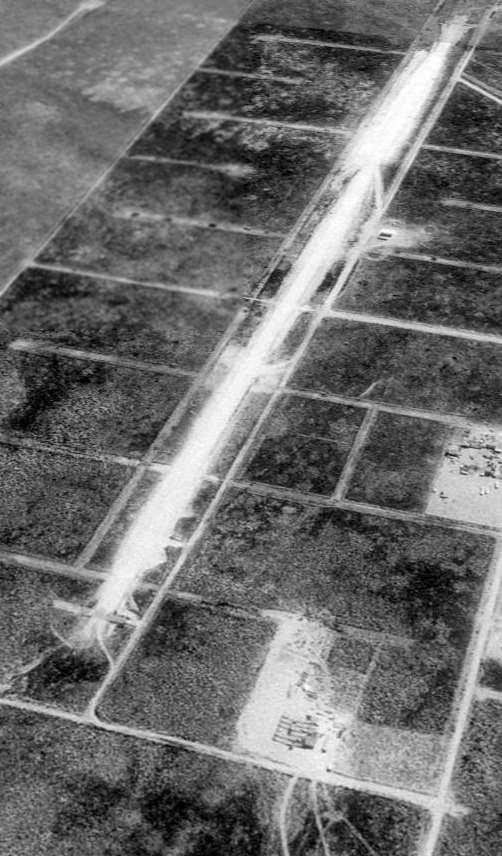
The earliest photo which has been located of the Valencia Community Air Ranch was a 5/4/91 USGS aerial view looking northeast,
which showed a single unpaved east/west runway.
The hangar on the southwest side (in the foreground) appeared to be possibly still under construction.
A 1/12/03 aerial photo showed an amazing sight at the southwest corner of Valencia Community Air Ranch:
dozens of light plane fuselages were stored around a small hangar (which had a hole in its roof),
and an intact Lockheed T-33 Shooting Star military jet trainer was parked next to the hangar among piles of debris.
A 2006 aerial photo showed no significant change at Valencia Community Air Ranch.
A 1/21/09 aerial photo showed that a short 1,700' dirt east/west runway had been added just to the northwest of the Valencia Community Air Ranch hangar,
paralleling the original runway.
The 1/21/09 photo showed a radio-controlled model aircraft on this smaller runway.
The 2009 Albuquerque Sectional Chart no longer depicted any airfield at this location.

A 3/21/12 aerial photo showed an amazing sight at the southwest corner of Valencia Community Air Ranch:
dozens of light plane fuselages were stored around a small hangar, with at least one other fuselage inside the hangar visible through a hole in its roof,
and an intact Lockheed T-33 Shooting Star military jet trainer was parked next to the hangar among piles of debris.

An 11/30/14 photo by Matt Franklin looking east from the end of the Valencia Community Air Ranch runway.
Matt reported, “The length of the runway is clearly elevated from the surrounding terrain,
but runs at around 20' above the surrounding area in some places & 15' or so below the terrain in the middle.
Both ends had asphalted turnarounds. From the east facing end its possible to see the aircraft that are discussed [above].”
Matt also reported that other portions of the runway are used “as an illegal dumping site.
Despite the dirt being clear & hard compact, it would be impossible to land here without blending a variety of couches, box TV’s, and car tires into a puree with a prop.”
Matt also reported that “the small runway next to the hangar is [Larry's] runway that he uses for full-size aircraft, not RC airplanes, although he hasn’t used it in quite a while.”

An 11/30/14 photo by Matt Franklin of the hangar at Valencia Community Air Ranch.
Matt reported, “I met a fantastic gentleman by the name of Larry who was kind enough to give me & my friend a tour of his property.
The first thing I noted about his hangar was actually the name on its side, which read Seven Bar Aviation.
I had flown out of the KABQ Seven Bar during my flight training tenure in the 2000’s before it was sold to Atlantic Aviation,
and I was familiar with their location at the Alameda Airport.
Larry confirmed he had purchased the Seven Bar hangar from the Alameda Airport & moved it adjacent to the Valencia Airpark.
Who would’ve guessed that a little piece of the legacy of Alameda would turn up 30 miles away, and still be used for storing aircraft?”

An 11/30/14 photo by Matt Franklin of the Lockheed T-33 Shooting Star military jet trainer which sits idle at Valencia Community Air Ranch.
Matt reported, “Larry owns the T-33, a plane he was anticipating to 'modify heavily', although other priorities changed his plans.
He had the original aircraft engine & a parts engine in the hangar.
He may start to sell parts as he gets older, but for now he's going to keep building airplanes.
You can see the canopy is yellowed but the desert air stops the rust, so there might be hope for this one.”

An 11/30/14 photo by Matt Franklin of the Beechcraft Bonanza fuselage inside the hangar at Valencia Community Air Ranch.
Matt reported, “We visited inside his hangar, which featured two 1947 Bonanzas, including line number 27 [pictured].
He also had the fuselages of a Piper 140 & a Piper 160, as well as a nifty Piper Six mix.
Larry told us he had built several airplanes, with a specialization in Pipers.
He would purchase aircraft that had been damaged by hail, wind, or bad piloting & swap the parts into a functional fuselage.
Typically this process would take 3 weeks, but he had rebuilt one such airplane in the space of one week.”
Valencia Community Air Ranch is located north of the intersection of Airport Drive & Airport Road.
______________________________________________________
Paradise Acres Airport, Alburquerque, NM
35.01 North / 106.71 West (Southwest of Downtown Albuquerque, NM)

Paradise Acres Airport was labeled simply as “Airstrip” on the 1960 USGS topo map.
Photo of the airport has not been located.
Not much is known about this small, short-lived general aviation airport.
Paradise Acres Airport was evidently established at some point between 1955-60,
as it was not yet listed in the 1945 AAF Airfield Directory (courtesy of Scott Murdock),
nor depicted on the 1955 USGS topo map or the 1960 Albuquerque Sectional Chart.
The only depiction which has been located of Paradise Acres Airport was on the 1960 USGS topo map,
which depicted a single northeast/southwest runway, labeled simply as “Airstrip”,
with a ramp & one small building on the east side.
George Atkinson recalled, “Paradise Acres Airport [was located] just off Coors & Gun Club Road.
It offered J-3 [Piper Cub] time for $8/hour.”
Dan McGrew recalled, “My uncle Don bought a Piper J3 that he kept at Paradise Airport.
We lived just down the road at 2113 Gun Club Road.
It was a small field but had some interesting planes.
I remember one huge storm that hit & really tore some of them up.
I remember this one pilot who had a pretty beefy J3 & in that center section of the airport,
did a figure-8 on the ground & lifted it off into the air.
Most amazing thing to this day I have seen anyone do with a plane.
I learned to fly my first plane out of this airport.
I was just 8 years old & my uncle had his license now.
I remember it was a silver/cream/pink Cessna 172.”
Paradise Acres Airport was evidently abandoned (for reasons unknown) by 1965,
was not depicted on the 1965 Albuquerque Sectional Chart (courtesy of John Price).
The 1969 USGS topo map no longer depicted Paradise Acres Airport, instead depicting several roads having been built over its location.
The 1991 USGS aerial photo depicted no remaining trace of Paradise Acres Airport,
the site having been covered with housing.

A 3/21/12 aerial photo showed no remaining trace of Paradise Acres Airport.
______________________________________________________
El Rancho Airport, Volcano Cliffs, NM
35.16 North / 106.73 West (Northwest of Albuquerque, NM)

El Rancho Airport, as depicted on the 1954 USGS topo map (courtesy of Laura Gleasner).
This private airfield was located northwest of Albuquerque.
Not much is known about it.
El Rancho Airport was evidently established at some point between 1951-54,
as it was not yet evident on a 1951 aerial photo (according to Laura Gleasner).
The earliest depiction which has been located of El Rancho Airport, was on the 1954 USGS topo map (courtesy of Laura Gleasner).
It depicted El Rancho Airport as a private field,
but with an atypically elaborate arrangement of of no less than 4 runways (the longest being the 3,500' northwest/southeast stirp),
with 2 taxiways & 2 small buildings on the east side.

The earliest photo which has been located of El Rancho Airport was a 1959 aerial view (courtesy of Laura Gleasner).
It depicted the field as having 4 runways, 4 taxiways, and 2 hangars on the east side.
There were no aircraft visible on the field, or any other signs of recent aviation activity,
but the runways appeared quite distinct, so it's possible the field had been newly-constructed at this point.
Given the elaborate layout of taxiways, might El Rancho have been constructed as a planned residential airpark community?
The 1960 USGS topo map continued to depict El Rancho Airport in the same fashion as shown on the 1954 USGS topo map.

El Rancho Airport had been abandoned (for reasons unknown) by 1962, as George Atkinson recalled, this “picture was taken on 2/11/62 at El Rancho Airport,
which had been abandoned, but runways were not too rough for an Ercoupe.
A sports car race was held on that day; this spectator arrived by air.”
Dan McGrew recalled, “The El Rancho Airport never got off the ground. I know, bad pun.
When I was 10 year oldish [1963] I remember a parachuting club that used the field.
They'd let the jumpers out above it & I could watch them from my house or my friends
and I would ride our bikes over the dirt roads to get as close as we could.
The planes wold land on the old strips & pick them up after they repacked & they'd do it all over.
This was around 1962-63. The airport was on top of Volcano Cliffs.”
El Rancho Airport was no longer depicted on the 1965 Albuquerque Sectional Chart (courtesy of John Price).

A 1967 aerial view (courtesy of Laura Gleasner) depicted El Rancho Airport in a considerably deteriorated fashion compared to the 1959 photo,
and the 2 buildings had been removed as well.
El Rancho Airport appears to have been a commercial venture that went “bust”.
The 1969 USGS topo map no longer depicted anything at the site of El Rancho Airport.

The last map depiction which has been located of El Rancho Airport was on a May 1977 Sandia Laboratories Environmental Impact Report.

The runway layout of El Rancho Airport was still plainly apparent in a 6/22/05 aerial photo.
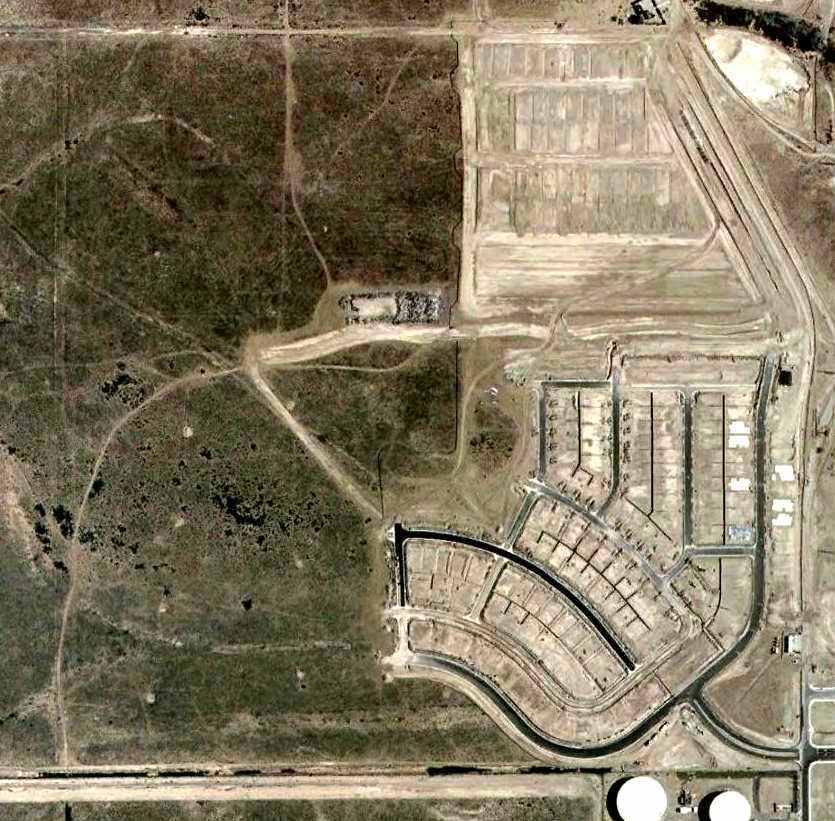
The last photo which has been located which still shows any trace of El Rancho Airport was a 1/1/06 aerial photo,
in which a housing development covered the eastern half,
but traces of the western portions of the northwest/southeast & east/west runways were still evident.
A 1/22/09 aerial view showed that the housing development had covered all of the site of El Rancho Airport,
erasing any trace of the airport.
The site of El Rancho Airport is located northwest of the intersection of Unser Boulevard & Molten Rock Road.
______________________________________________________
Oxnard Field / (Original) Albuquerque Airport / Mobile Air Depot, Albuquerque, NM
35.04 North / 106.56 West (East of Kirtland AFB, NM)

A 1928 photo of an Albuquerque Airport hangar & R.L. Harrison's Butler biplane at Oxnard Field.
Many residents of Albuquerque probably assume that the town's original airport
was situated on the site which eventually evolved into today's Albuquerque International Airport / Kirtland AFB.
However, this is not correct – the original Albuquerque Airport was actually a separate airfield,
located to the east of the eventual location of Albuquerque International Airport / Kirtland AFB.
In 1928, Frank Speakman & William Franklin, 2 Santa Fe railroad employees,
inaugurated a private venture for an airport (according to the Kirtland AFB website).
Working with the town of Albuquerque, they graded 2 runways on East Mesa
with one approximately 5,300' long & the other just under 4,000'.
It was constructed on 140 acres of homestead land (according to the Sandia National Laboratories website).
Albuquerque Airport was wholly a private venture, irrespective of the town’s involvement.
Immediately following construction of the airport,
other individuals and promoters became interested in Albuquerque as a crossroads location for southwestern air traffic.
James Oxnard, a New York entrepreneur, bought Franklin’s interest in Albuquerque Airport,
expanding the facility toward the end of 1928.
The earliest directory listing of the field which has been located
was in the 1929 Airplane Landing Fields of the Pacific West (courtesy of Chris Kennedy).
It described the Albuquerque Airport as a commercial field, measuring 5,280' x 3,960'.
The field was said to have 2 runways: 4,300' east/west & 2,500' northeast/southwest.
A hangar, administration building, and T.A.T. Office building
were said to be located along the center of the north side of the field.

A circa 1930 aerial view looking east at the hangars & runways of the original Albuquerque Airport.
As the decade closed, 2 airlines initiated competitive passenger, mail and cargo service between the Midwest & California,
positioning Albuquerque as an important transcontinental airfield.
Shortly after beginning activities, one of the companies, Western Air Express,
decided to build its own airport on the West Mesa.
This airport became known as Albuquerque Airport,
while the former Albuquerque Airport on the East Mesa took on the name Oxnard Field, continuing as a private venture.

The earliest aeronautical chart depiction which has been located of the original Albuquerque Airport was on the 1932 Albuquerque Sectional Chart,
which depicted Albuquerque as a commercial/municipal airport.

A 1935 photo of Earl Ortman's Rider-Clark NR 14215 #9 being refueled at Oxnard Field during the Bendix Trophy Race.
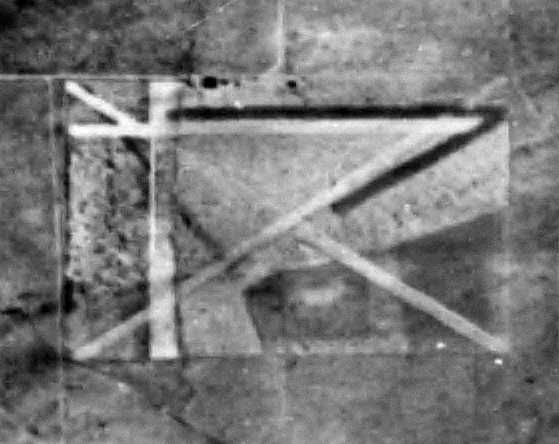
A 1935 aerial view of the Albuquerque Airport (from the NM RGIS, courtesy of Chris Kennedy)
depicted the field as having 4 runways, with a few buildings along the north side of the field.
The January 1, 1936 “Descriptions of Airports & Landing Fields in the U.S.” (according to David Brooks)
described the “Albuquerque Airport” as a commercial field,
having 2 dirt runways, measuring 4,000' east/west & 2,500' northeast/southwest,
with a comment that the entire field was usable.
It had at least one hangar, with “Albuquerque Airport” painted on the roof.

An aerial view looking southwest at the original Albuquerque Airport
from The Airport Directory Company's 1937 Airport Directory (courtesy of Bob Rambo).
The directory described Albuquerque as a commercial field, measuring 480 acres in size, with a sandy surface.
The field was said to have 2 runways: 4,000' east/west & 2,500' northeast/southwest.
A cluster of hangars was depicted along the south side of the field,
one of which was said to have “Albuquerque Airport” on its roof.

The 1938 USGS topo map depicted a set of 4 small buildings on the south side of the road,
labeled simply as “Airport”, but did not depict any runways or other airport features.
In mid-1939, the City of Albuquerque opened a new Albuquerque Municipal Airport approximately 4 miles west of Oxnard Field.
As of late 1939, Army & Navy pilots began using Oxnard Field for refueling & maintenance for a variety of military flights.
The Army eventually took over the Oxnard Field property for military use, with subsequent transfer to the federal government.
The Albuquerque Airport was used as a stopover for air crews
ferrying California-built bomber aircraft to England in the late 1930s & early 1940s.
The original Albuquerque Airport was depicted as a commercial/municipal field
on the April 1941 Albuquerque Sectional Chart (courtesy of Chris Kennedy).
The chart also depicted the newly-constructed Albuquerque Municipal Airport,
which had been constructed adjacent to the west side of the original Albuquerque Airport.
The number of runways at Albuquerque was increased to 6 at some point between 1937-41,
as The Airport Directory Company's 1941 Airport Directory (courtesy of Chris Kennedy)
described Albuquerque as having a total of 6 runways, with the longest being the 6,600' northeast/southwest strip.
In late 1942 the Army Air Forces acquired Oxnard Field (approximately 11,000 acres to the east of Kirtland Field),
and construction began on the Albuquerque Air Depot Training Station, a training depot for aircraft mechanics.
The January 1942 Albuquerque Sectional Chart (courtesy of Chris Kennedy)
still depicted the original Albuquerque Airport was depicted as a commercial/municipal field.

A 1942 aerial view looking east (courtesy of Bill Eaton) showed Kirtland Field (foreground) and the original Albuquerque Airport in the background.

The 4 runways of the original Albuquerque Airport were depicted to the east of Kirtland Field on a 1943 plan, inside an outline labeled “Air Depot Training Station”
(from the St. Louis National Personnel Records Center, courtesy of Ron Plante).

The original Albuquerque Airport was depicted as a military airfield, labeled “Mobile Air Depot”
on the 1943 Albuquerque Sectional Chart (courtesy of David Brooks).
The February 1944 Albuquerque Sectional Chart (courtesy of Chris Kennedy)
labeled the field as “Albuquerque (Aux) Army Air Field”.
During the latter part of WW2, Oxnard Field was transferred from the jurisdiction of the Army Air Corps
to the U.S. Army Service Forces Chief of Engineer District
and thereafter assigned to the Manhattan Engineer District (otherwise known as “The Manhattan Project”).
In July of 1945, the forerunner of Sandia Laboratory, known as "Z" Division,
was established at Oxnard Field to handle future weapons development,
testing, and bomb assembly for the Manhattan Engineer District.
The "Z" Division facilities originally consisted of wood sheds & buildings.

The ramps of Oxnard Field were covered with a large number of objects (buildings or possibly surplus aircraft).
A June 1946 Department of Commerce Airman's Guide (according to Chris Kennedy)
described the original Albuquerque Airport as of 6/6/46 as “Used by the Reconstruction Finance Corporation.
Available only for delivery of surplus aircraft to this field,
prospective purchasers of surplus aircraft or parts, or in emergency.”

The last depiction which has been located of the original Albuquerque Airport as an active airfield
was on the September 1948 Albuquerque Sectional Chart (courtesy of Chris Kennedy).
It depicted the original Albuquerque Airport as an auxiliary airfield.
The Manhattan Engineer District's "Z" Division used temporary buildings
until construction of more permanent buildings for an expanded facility began in 1948.

The original Albuquerque Airport was evidently closed at some point between 1948-49,
as it was depicted on the 1949 USAF Pilot's Handbook (courtesy of Chris Kennedy) as “Albuquerque (Abandoned)”.
It was depicted as having 4 runways.
By the time of the September 1954 Albuquerque Sectional Chart (according to Chris Kennedy),
the original Albuquerque Airport was no longer depicted at all.

A 1995 photo by Michael Horne of the pre-1930 hangar which remained standing at the site of Oxnard Field,
now part of the property of Kirtland AFB.
The former airfield buildings were being used by the Air Force for vehicle maintenance.
Note the missiles on display to the left of the hangar.

A 1995 photo by Michael Horne of the pre-1930 former terminal building which remained standing at the site of Oxnard Field,
now part of the property of Kirtland AFB.

More than 50 years after the original Albuquerque Airport was closed,
the 2002 USGS aerial photo still showed the recognizable trace of the former northeast/southwest runway.
The remaining hangar & terminal building are at the top-right.
Note the B-52 & other static aircraft among the collection of the National Atomic Museum, just east of the hangar, at top-right.
The runways of the present-day Kirltand AFB are adjacent to the site to the west.

A circa 2005 aerial photo looking north at the pre-1930 terminal building & hangar which remains at the site of Oxnard Field.
The site of the original Albuquerque Airport is located southeast
of the intersection of Hardin Drive Southeast & Pennsylvania Avenue Southeast.
______________________________________________________
Western Air Express Airport / West Mesa Airport, Albuquerque, NM
35.08, -106.72 (West of Downtown Albuquerque, NM)

A 1930 photo of the interior of the Western Air Express terminal building (courtesy of David Brooks).
Note the portrait of Charles Lindberg hanging over the fireplace.
This early commercial airline airport was located on the west side of Albuquerque.
The date of construction of the field has not been determined.
The earliest reference to the field which has been located
was in the 1929 "Standard Oil of CA Airplane Landing Fields of the Pacific West" (courtesy of Chris Kennedy).
It listed the field under its original named of "Western Air Express" Airport.
The field was said to consist of a 1,000' acre square property,
in which was an airfield with four 6,600' rolled sand & clay runways in the "shape of an 8-point star".
A hangar & administration building was said to be "under construction".
The earliest depiction which has been located of the Western Air Express Airport
was a 1930 photo of the interior of its terminal building (courtesy of David Brooks).

The earliest aeronautical chart depiction which has been located of Western Air Express Airport was on the 1932 Albuquerque Sectional Chart,
which depicted Western Air Express as a commercial/municipal airport.
The Airport Directory Company's 1933 Airport Directory (courtesy of Chris Kennedy)
described the "Transcontinental & Western Air" Airport
as having four 5,300' runways in a "star shape".

The 1934 USGS topo map depicted a road leading to 2 small buildings,
labeled simply as “Landing Field”, but did not depict any runways or other airport features.
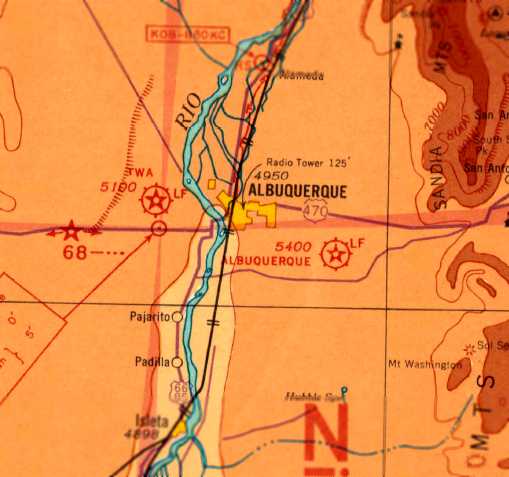
The April 1935 Albuquerque Sectional Chart (courtesy of Dan Deloria)
depicted “TWA” as a commercial/municipal field.

A 1935 aerial view of the West Mesa Airport (from the NM RGIS, courtesy of Chris Kennedy)
depicted the field as having 4 runways in a star pattern, with a building southeast of the runway intersection.

An aerial view looking northwest at the "Transcontinental & Western Air" Airport
from The Airport Directory Company's 1938 Airport Directory (courtesy of Chris Kennedy).
The directory described the field as having four 5,280' sandy loam runways.
A single building was depicted on the southeast side of the runway intersection.
The manager was listed as M. B. Joyner,
and the operator was listed as Transcontinental & Western Air,
which provided scheduled transport service, airplane sales & service, charter, and instruction.

The field was evidently renamed "West Mesa" Airport at some point between 1938-41,
as that is how it was depicted on the April 1941 Albuquerque Sectional Chart (courtesy of Chris Kennedy).

A circa 1942-45 aerial view looking north from the 1945 AAF Airfield Directory (courtesy of Scott Murdock)
depicted the characteristic 8-point star layout of West Mesa Airport.
The directory described West Mesa as a 715 acre irregularly-shaped property having 4 bare runways,
the longest being the 6,000' north/south strip.
The field was said to have 2 hangars, the largest being a 110' x 100' concrete & metal building.
West Mesa was described as being owned by the Town of Atrisco, and operated by private interests.
West Mesa was said to have an “auxiliary field” (unusual for a civilian airport?): Cutler-Carr Field #2, located 6 miles ENE.
According to the Cutter Aviation website, during WW2, “the U.S. Navy designated Cutter as a Naval Air Training School as part of the Civilian Pilot Training Program
at its primary business location at West Mesa Airport in Albuquerque.
Cutter moved to the larger Albuquerque International Sunport in 1947 as activity at West Mesa Airport began to decline,
but continued to offer refueling from West Mesa.”

A 1950 photo of refueling a twin Beech in front of the Cutter-Carr Flying Service hangar at West Mesa Airport (courtesy of Jim Hackman).
Jim Hackman recalled, “West Mesa Airport... I landed there while ferrying a no-radio/lights Super Cub from Lockhaven to Visalia, CA in 27:45 & 5 days!”
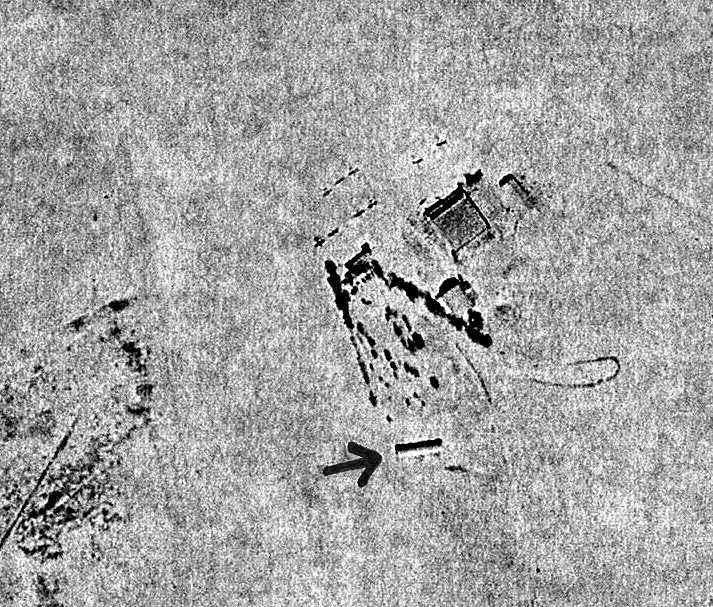
A 1951 aerial view depicted 9 light aircraft around the hangar at West Mesa Airport (courtesy of Brett Hamby).
Henry Meyer recalled, “I learned to fly at old West Mesa in 1955.
I remember the crash of an experimental [aircraft] in Summer of 1955 after the pilot was thrown out by the aircraft's quick roll.”

The last photo which has been located showing West Mesa Airport was a late 1950s photo by Dan Rhinehart of an Aeronca at West Mesa Airport.
According to the Cutter Aviation website, “Cutter continued to offer refueling from West Mesa until the late 1950s.”
Dan McGrew recalled, “Around 1959, when I was 6 yesr old my uncle, Don Tyrack, started flying.
He started flying out of then West Mesa Airport & had gone in on a Piper Cub with a couple of buddies.
I use to go with him all the time & hang out at the airport while he either flew or was taking lessons.
There was a drive-in movie theater off the southeast corner of the airport.
There were no commercial flights into it anymore as they all went into the Sunport by then.”

The 1960 Jeppesen Airway Manual (courtesy of Chris Kennedy) depicted the distinctive arrangement of West Mesa Airport,
with 4 unpaved runways arranged in a star (with the longest being the 6,300' Runway 16/34).
A ramp with a single building was depicted on the southeast side of the airfield, directly in line with Runway 29.
Barry Sylvester recalled, “I recall going out to West Mesa Airport around 1960 & watching sailplanes.
The gliders relocated to a airstrip near Moriarty to get away from increasing air traffic.”
According to Diane Schaller (President, Historic Albuquerque Inc.), “After Cutter-Carr Flying Service consolidated its organization at the Albuquerque Municipal Airport, vacating West Mesa Airport,
Western Air of Albuquerque, Inc. leased the entire West Mesa property in 1964.
Western Air, owned by Richard Durand Jr., ran a used airplane operation where they bought,
renovated (paint, upholstery & minor engine work) and sold all kinds of small- to medium-sized aircraft.”

An advertisement for Western Air Inc.'s operations at West Mesa Airport from the 10/8/64 Albuquerque Journal According to (courtesy of Diane Schaller, President of Historic Albuquerque Inc.).
According to Diane Schaller (President, Historic Albuquerque Inc.), in 1965 Western Air moved from West Mesa Airport to Coronado Airport.

The 1965 Albuquerque Sectional Chart (courtesy of John Price) depicted West Mesa as having a 6,300' unpaved runway.

The last aeronautical chart depiction which has been located of West Mesa Airport
was on the August 1967 Albuquerque Sectional Chart (courtesy of Chris Kennedy).
It depicted West Mesa as having a 6,300' unpaved runway.
The West Mesa Airport was was no longer depicted at all on the February 1968 Albuquerque Sectional Chart (according to Chris Kennedy).
Barry Sylvester recalled, “There were parachuting operations on West Mesa Airport in the late 1960s & early 1970s,
but increasing air traffic at the municipal airport became a problem.”
Dan McGrew recalled, “The airport was closed when Albuquerque Public Schools
bought some of the land on the North end of the field & built West Mesa high. I attended it in 1968 when it opened.”

A 5/29/73 aerial photo (courtesy of Rob Haulenbeek) showed the characteristic star-shaped runway layout of West Mesa Airport was still recognizable,
although buildings had started to be constructed over the site.

The entire intact runway layout of West Mesa Airport was still shown on the 1996 USGS topo map,
almost 30 years after the field had been closed.

In contrast to the topo map from the same year,
the 1996 USGS aerial photo showed that the site of the airport had already been built over by a number of new streets & buildings.
However, in spite of the construction, the outline of several of the former runways was still recognizable,
particularly the western half of the runways.

Although the 2002 USGS aerial photo showed that further construction had covered up even more of the former West Mesa Airport,
one very recognizable trace of the airport still remained - the northwestern half of Runway 11.

An August 2007 aerial view by Neal Lawson looking southeast at the recognizable outline of the former Runway 11 at West Mesa.
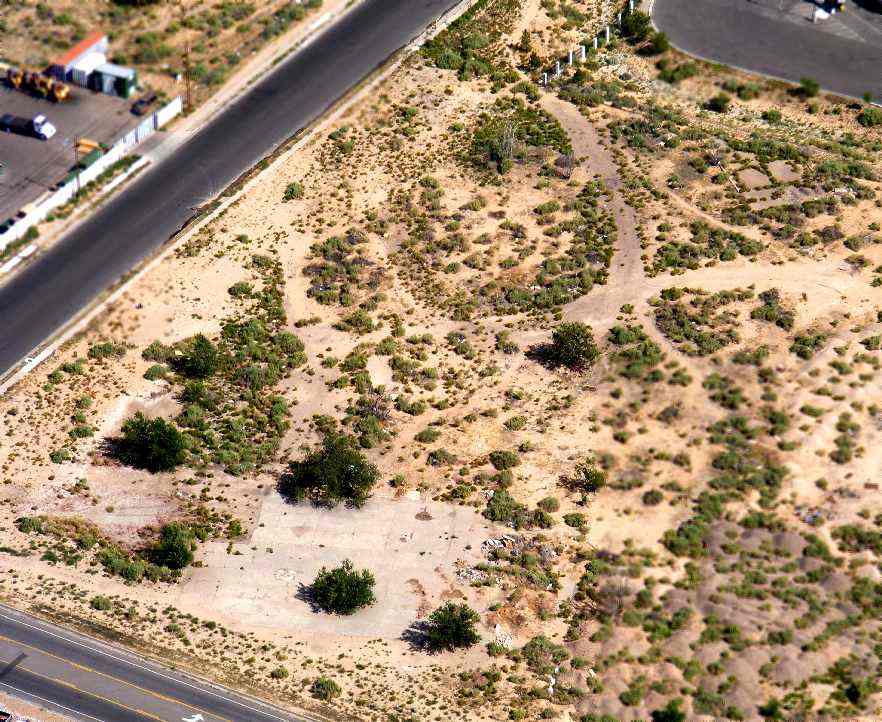
An August 2007 aerial view by Neal Lawson looking southeast at several remaining traces of the West Mesa Airport.
The remains of the airport loop road is at the top-center,
and the foundation of the former hangar / administration building is at lower left, with bush growing out of it.
Both of those features were depicted on the 1996 USGS topo map.
The road in the upper left is Airport Road NW, and the road at the bottom left is Meridian Road NW.

A November 2007 photo by Daniel Stallings of the remains of a foundation at the site of the West Mesa Airport.
According to Daniel, “These will might be some of the last photographic evidence of the West Mesa Airport
as the site will likely be graded for construction in the near future.”

A November 2007 photo by Daniel Stallings of the remains of a foundation at the site of the West Mesa Airport.

A November 2007 photo by Daniel Stallings of the remains of a foundation at the site of the West Mesa Airport.
The site of West Mesa Drive is located north of the intersection of Los Volcanes Road NW & Airport Drive NW,
appropriately enough.
______________________________________________________
Sandia Base Airfield, Albuquerque, NM
34.97 North / 106.49 West (Southeast of Albuquerque International Airport, NM)

Sandia Airfield, as depicted on the December 1968 Albuquerque Sectional Chart (courtesy of Chris Kennedy).
Photo of the airfield while in use has not been located.
The Sandia National Laboratory dates back to 1945,
when the "Z Division" established as the ordnance design, testing, and assembly arm
of Los Alamos National Laboratory.
For the past 40 years, Sandia has continued to conduct extensive research
in support of nuclear weapons programs & other national-security related projects.
A small airfield was located on the southeastern edge of the Sandia National Laboratory property
(the little Sandia Base Airfield is not to be confused with the much larger Kirtland AFB,
which is located only 7 miles to the northwest).
The Sandia Base Airfield may have been established at some point between 1962-63,
as it was not depicted at all on the 1962 Albuquerque Sectional Chart.
The earliest reference which has been located to the Sandia Base Airfield came from Ben Thurston,
who recalled, “Sandia Base... I did my initial Private Pilot's License training there, probably starting in 1963 or 1964.
I was in the Navy, but stationed at the University of NM on a Navy college program.
[The Sandia Base Airport] was run by a military flying club, so I had access by way of my Navy status.
I recall flying 2 versions of Piper Cubs - one without & one with flaps - perhaps PA-11s & PA-18s.
Depending on winds, this was in the lee of the Manzano Mountains, just to the east,
so on a gusty day it could be challenging to a new student in a lightweight plane with a big wing!
I also don't remember a cross runway - that may have come later.
So anyone who did initial training there in taildraggers has never had a problem with crosswind landings since!
Buy my most vivid memory is hand-propping a stiff engine on a cold NM morning (nearly 6,000' elevation).
One could definitely work up a sweat before it fired!”
Sandia Base Airfield was not yet depicted on the 1965 Albuquerque Sectional Chart (courtesy of John Price).
The earliest directory listing which has been located of the Sandia Base Airfield
was in the 1967 AOPA Airport Directory (courtesy of Chris Kennedy).
It described the "Sandia Base Airstrip" as a "Private airstrip closed to the public",
operated by the "Sandia Military Flying Club".
It was described as having 2 dirt runways: a 4,200 Runway 2/20 & a 3,800 Runway 8/26.
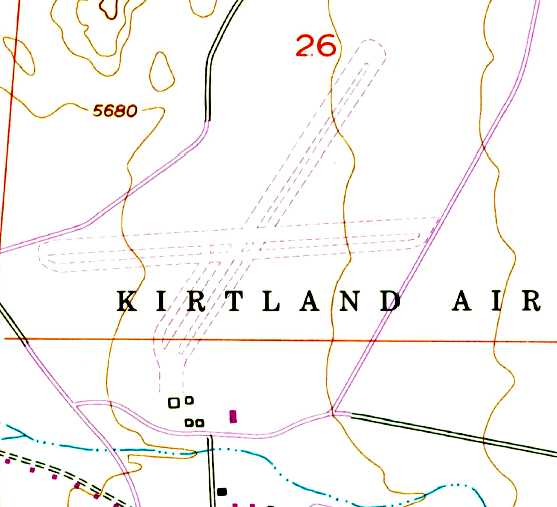
The 1967 USGS topo map depicted the Sandia Base Airfield as having 2 unpaved runways each with a parallel taxiway,
and several small buildings on the south side.
The airfield was unlabeled, but the overall property was labeled “Kirtland AFB”.
Sandia Airfield was still depicted as an active private airfield
on the December 1968 Albuquerque Sectional Chart (courtesy of Chris Kennedy).
"Sandia" Airfield was still depicted on the 1970 USGS topo map,
but this does not necessarily prove the airfield was still active at that point.
The Sandia Base Airfield was evidently abandoned by 1975,
as nothing at all (not even any runways) was depicted at the same location on USGS topo maps from 1975 or 1995.
The 1996 USGS aerial photo of the site depicted the remains of an airfield with 2 (or possibly 3) runways,
with the longest being a 5,000' east/west strip.
The east/west & northeast/southwest runways had parallel taxiways.
A large ramp is located at the southwest end of one runway,
while a smaller ramp is located south of the west end of the primary runway.
A complex of buildings sits just south of the airfield,
but this may have been unrelated to the airfield, constructed after the airfield had been abandoned.
The airfield was no longer depicted at all (even as an abandoned airfield) on the 1998 World Aeronautical Chart.
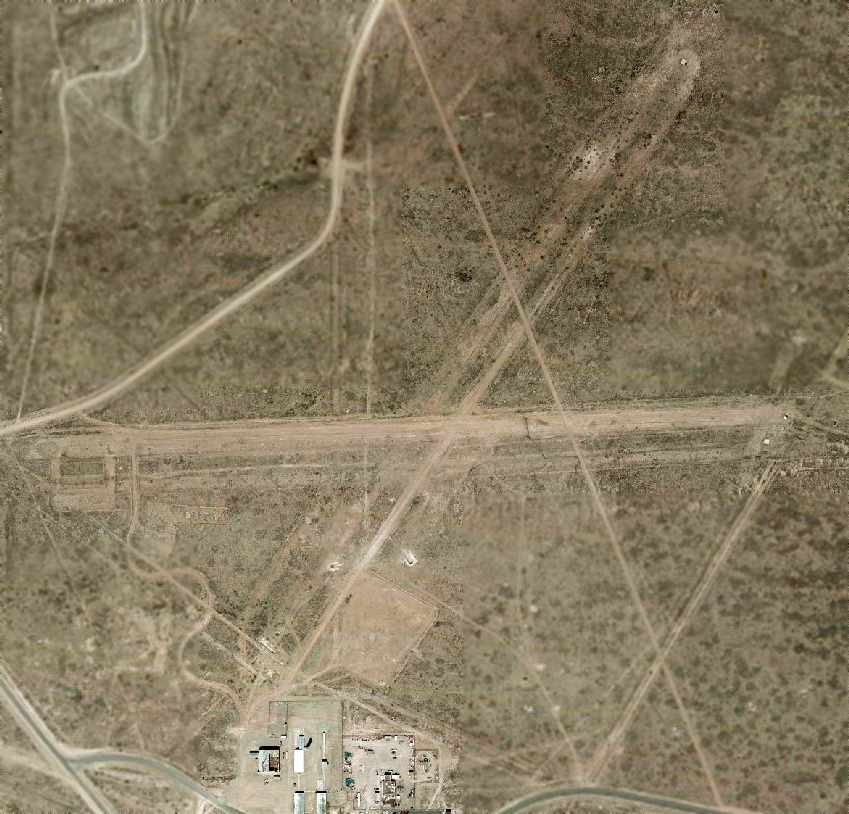
The 2002 USGS aerial photo showed that the airfield remained completely intact.
Thanks to Chris Kennedy for pointing out this airfield.
______________________________________________________
Coronado Airport (4AC), Albuquerque, NM
35.2, -106.57 (North of Albuquerque International Airport, NM)

A 1962 photo by Robert Sylvester of his Cessna 182 N9956B at Coronado Airport's east tie-down area (courtesy of Barry Sylvester).
The abrupt & arbitrary closure of this vibrant general aviation airport in late 2001
is yet another example of the continuing disappearance of airports which serve the general aviation community.
This is a trend which must be fought.
No airfield was yet depicted at this location on the 1960 USGS topo map.
Coronado Airport was opened in 1961.
Dan McGrew recalled, “We were at opening day for Coronado Airport. I spent many hours there.
My other uncle, Bob Jansson, became a pilot too.
He got into aircraft sales & was active in it.
There was another pilot at Coronado, Dick Durand, who had a P-51.
Dick took me up in it once. Talk about a thrill!
One of my instructors use to have me take my Cessna 150 over to Coronado to do crosswind landing & take offs.
The winds against the base of the Sandias could be brutal.”
Barry Sylvester recalled, “My Dad, Robert Sylvester learned to fly at Coronado in 1961,
and based his Cessna 182s there from 1961 until he retired in 1982.
Over the years, we flew VFR all over the Country. On Holiday weekends, we would fly to Central Texas (Lake LBJ), landing on a little airstrip in the village of Granite Shoals.
There was a tie-down area on the East side of the main runway.
T-Hangar rental was $50/month, paved tie-downs were $15, and the East unpaved tie-downs were $10/Month.”

Coronado Airport, as depicted on the December 1962 USAF Operational Navigation Chart (courtesy of Chris Kennedy).
Coronado Airport was listed among active airports in the 1962 AOPA Airport Directory,
with 2 paved runways, and the operator listed as Southern Skyways.
Thomas van der Geld recalled, “I soloed in a Cessna 150 on the morning of my 16th birthday (in 1963) at Coronado.
I can still very vividly remember that morning as well as the preceding weeks with my flying instructor...
a great Texan named Jim Pollard who lived for flying.”
According to Diane Schaller (President, Historic Albuquerque Inc.), in 1965 Western Air moved from West Mesa Airport to Coronado Airport.

The 1965 Albuquerque Sectional Chart (courtesy of John Price)
depicted Coronado Airport as having 2 paved runways, the longest being 4,200'.

The 1967 USGS topo map depicted Coronado Airport as having 3 paved runways, 2 with parallel taxiways, and 9 hangars along the west side.

A 1967 photo of Robert Sylvester & his Cessna 182 N2206G at Coronado Airport's east tie-down area (courtesy of Barry Sylvester).
John Kern recalled, “I flew a great deal out of Coronado Airport.
The man at Coronado had a flight school with the old $5 Cessna rides
and they also did lots of conversion of large old aircraft into business & corporate planes.
I spent many hours 'hangar flying' with the folks at Coronado.”

A 1970 photo courtesy of Dan Rhinehart of P-51 Mustang 'Miss Albuquerque' at Coronado Airport.
Dan Rhinehart recalled, "I'll never forget being about 4 years old & going to Coronado
and getting there in time to see my dad & a friend of his land in a bright red P-51, 'Miss Albuquerque'.
Coronado was one of these places that just never changed
and it looked the exact same way that it did the 1st time I ever remembered going there (about 1970)
as well as the last time I was there while the airport was still open (1999).”

An undated aerial view looking northeast at Coronado (courtesy of Dana Patton).
Larry Nussbaumer recalled, “I flew for Coronado Flying Service & Pegasus Aerial Sports (gliders, Stearman, etc.)
out of Coronado throughout the 1970s.”
Barry Sylvester recalled, “I was a member of the Icarus Sport Parachute Club in Albuquerque from 1978-82.
Our aircraft were based at Coronado (2 Cessna 180s & a 206).”

A January 1986 photo by Steve Schmidt of his Piper Tripacer at Coronado.
Steve recalled, “I took this photo of my plane on the ramp directly in front of the offices (FBO terminal).
I had recently completed a taildragger conversion to the former Tri-Pacer.
Note the incredible view that Coronado airport had of the Sandia mountains on the east side of Albuquerque.
Coronado was a great place to sit & enjoy a great sunrise & sunset - sad to see that the sun has truly set on 4AC.”
Steve Schmidt recalled of Coronado Airport, “I had my Piper Pacer hangared there for several years in the 1980s.
Coronado was like others stated already - a place that really never changed.
The desert just kept it looking just as it was, regardless of what year you were there.
Runway 17/35 was 4,100' long, but also just 45' wide.
With the field elevation of 5,270', the small little runway ate a few 'lower elevation' fliers
when they came in to 4AC to take on fuel, rather than go into Albuquerque International.
I saw 2 aircraft personally that tried to push a full-weight, full-fuel takeoff on a hot day
and ended up in the cemetery at the south end of the runway.”
Steve continued, “The airport had a vibrant community in the 1980s, with ultralights, EAA, antiquers
and even warbirds all mixing with the business aircraft that came & went.
There always seemed to be something in the pattern, shooting touch-n-go's.”

A January 1986 photo by Steve Schmidt of a Partenavia on amphibious floats (a very rare bird) at Coronado.
Steve recalled, “This Partenavia spent some time at Coronado in 1986.
It is parked in front of the large maintenance hangar that the FBO operated from on the north end of the field.
I recall that a company in NM called DeVore Aviation might have been doing something with the plane, but I really never learned why it was at Coronado.
I do recall that many of us had wondered if it could actually fly!
It did, though I personally did not see it depart.
For months it was there, then, gone. I sure would have like to have seen that takeoff!”
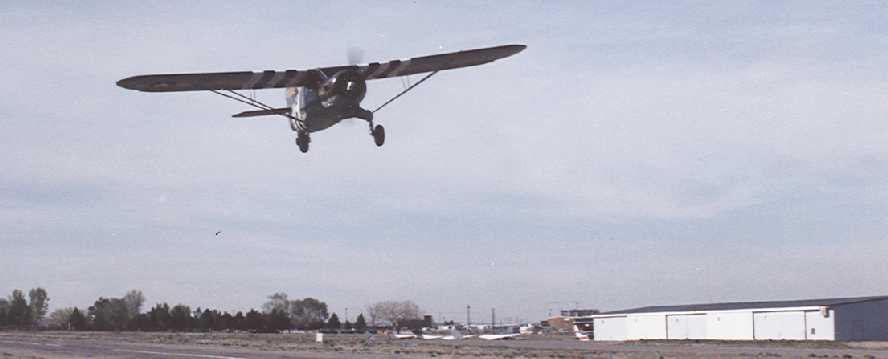
A May 1986 photo by Steve Schmidt looking southwest at of a Noordyun Norseman taking off from Coronado.
Steve recalled, “This Noordyun was restored at Coronado by a pair of enthusiasts over a couple years in the 1980s.
The plane was in D-Day markings, and left New Mexico in the late 1980s to first be in a Galveston museum, now it is back doing bush work in Canada.
Note the trees in the background; these designate where the cemetery is at the south end of the field.”

A 2/20/88 aerial view by Steve Schmidt looking northeast at Coronado Airport.
Steve recalled, “The photo was taken out of a left side window of a Ford Trimotor (N414H) as we were on an hour flight over Albuquerque.
Two old-timers, 4AC & N414H. Unfortunately only N414H continues to thrive.
Coronado was a special place for me when I lived in ABQ & had my aircraft hangared there.”

An undated aerial view looking west at a Coronado Airport ramp filled with light aircraft (courtesy of Dana Patton).

An October 1991 photo by Jane Fagan (courtesy of Dave Fagan) of a "most unusual aircraft marshaller" at Coronado Airport,
taken "during the Albuquerque Balloon Festival -
so the airfield was very busy with a large number of visiting aircraft."
Unfortunately, Coronado was privately owned, not a municipal facility.
This left it vulnerable to purchase by those who would desire to use the property for other purposes.
The airport was purchased in 1994 by the “Sandia Business Development Corporation”.
It later became evident that the sole shareholder of this Corporation was the local Indian tribe, the Pueblo of Sandia.
Brady Butterfield recalled, “I soloed on my 17th birthday at Coronado on 9/5/96. I loved that little airport.
The people there were really good folks, they were very helpful & had some good ol’ flying stories.
The airport was perfect for a new pilot flying a Cessna 172 with that very narrow runway.
I will always remember turning onto final & then coming down through the trees in the cemetery to meet the end of the runway.
I remember those big pines being just off the wingtips before touch down on my short field practices. N733HF was a great little plane.
My future wife & I used to sneak out onto the runway in the middle of the night and lay on the runway centerline.
I’m not really sure why, but it sure was fun.”

A circa 2000 aerial photo of Coronado Airport, shortly before it was closed.
Note the blimp moored in the center of the photo.

The last aeronautical chart depiction which has been located of Coronado Airport was on a 2000 NM Aeronautical Chart (courtesy of Aaron S.).
Coronado was depicted as having 2 paved runways, with the longest being 4,000'.
Aaron S. recalled, “I flew briefly out of 4AC in July of 2001 to get my complex endorsement in a PA28R200 Piper Arrow at Akin Air, from Cordell Akin himself.
Hard to believe that was only a few months before it closed.”
Coronado was last listed in the Airport Facility Directory in 2001.
The airfield consisted of 2 paved runways (the primary runway, 17/35, was 4,100' long), taxiways, a ramp, and 12 hangars.
A total of 131 aircraft were listed as being based at the field,
and the airport was listed as having an average of 237 aircraft operations per day.
Business at Coronado included an FBO, Skycraft, a flight school, Akin Air, and a pilot shop, ABQ Pilot Shop.

The last photo which has been located showing aircraft at Coronado Airport
was a 10/9/01 photo by Bill Teasdale of a Cessna 182 & several other aircraft in front of the FBO office.
The Indian tribe which had purchased the airport property
proceeded to build a large casino just off the end of Coronado's Runway 17,
which would seem to any reasonable person to be an incompatible use for the property.
The tribe obviously had other plans.
In late 2001, in a press release entitled "Safety Forces Closure Of Coronado Airport",
the tribe announced they were closing the airport.
The fact the airport preceded the casino by 40 years did not seem to matter,
and was certainly not mentioned in a press release in which the tribe stated that "the public's safety is our priority."
It also didn't matter that the airport was a vibrant economic entity, with 3 active businesses,
or that it was well used, with over 100 aircraft based on the field.
Contractors were sent to paint yellow closed-runway Xs on the runways & taxiways,
the airport businesses were evicted,
and over 100 aircraft were forced to relocate.
That left the entire Albuquerque metropolitan area with just one general aviation airport, Double Eagle II.

A poignant 2003 view of the former office of Coronado Airport, by Dan Rhinehart.

A hangar which remains at the former Coronado Airport, by Dan Rhinehart, 2003.

A 2003 photo of a former runway at Coronado Airport, by Dan Rhinehart.

A fine aerial view looking north at the sad remains of the former Coronado Airport, by Dan Rhinehart, 2003.
Dan observed, “If you look to the one end of the runway you can see that it now has a drainage ditch running through it.
The Indians used the need to run a drainage ditch across the runway as an excuse to close the airport.
The local pilots association pointed out that they could close the runway for a few days
and run a piece of pipe under the runway with minimal cost.
But as we all know the drainage ditch was just an excuse to close the airport.
I was talking to a local pilot about this and he explained
that the airport was on property adjacent to the Sandia Reservation
and even though this land could never be annexed by the tribe.
It appears that Coronado Airport had hazardous waste contamination on the property
and that it was not worth a lot due to that and the fact that it's in an area of town
that's predominately automotive salvage yards....etc.
The one thing that the Sandia Tribe had going for it that no other buyer did
was that they could sucker the federal government into paying to clean up the land no matter the cost.
I took a lot of pictures there in that I can only imagine that it will be fading into the desert soon
and all that will be left is a few old pictures."
Albuquerque pilot Neal Lawson reported, “The hangars & other buildings at Coronado Airport
were torn down over the winter of 2006-2007.
What's next - a strip mall?”

A March 2007 aerial view by Neal Lawson looking north at the remains of Coronado Airport,
showing the runways which remain, but all of the buildings & hangars having been wiped clean.

An 8/10/09 photo looking along the cracked former runway pavement at the site Coronado Airport,
with the casino which caused its demise seen in the left background.
Steve Schmidt recalled, “I moved away & was very sad to hear of the political end that befell Coronado.
With Albuquerque's wonderful climate, aviation just goes along with it.
Now, someone living on the east side of the community faces a 40 mile drive to the only general aviation airport in that large city.
That's really too bad.”
______________________________________________________
Seven Bar Airport / Alameda Airport (Q64), Albuquerque, NM
35.2 North / 106.66 West (North of Albuquerque International Airport, NM)

Seven Bar Airport, as depicted on the 1954 USGS topo map.
This general airport is one of several which have disappeared
in the past few decades from the Albuquerque metropolitan area.
Seven Bar Airport was evidently established at some point between 1951-54,
as it was not yet listed in the 1945 AAF Airfield Directory (courtesy of Scott Murdock) nor depicted on the 1951 USGS topo map.
The earliest depiction of Seven Bar Airport which has been located was on the 1954 USGS topo map.
It depicted Seven Bar Airport as having 2 paved runways & parallel taxiways, and a ramp with a few small buildings on the east side.
It was evidently renamed Alameda Airport at some point between 1954-55,
as the 1955 Albuquerque Sectional Chart (according to Chris Kennedy)
depicted Alameda Airport as having 2 runways, with the longest being a 3,700' bare strip.
Dan McGrew recalled, “In 1960 we moved to Paradise Hills.
The airport on that side of town was Alameda or 7-Bar as it was known. It was owned by Rolf Black.
The Black family owned a lot of land that is now Rio Ranch.
My Uncle Bob became a partner in aircraft sales with Rolf & then worked at 7-Bar.
Later when Bob went his separate way, he still kept his planes at 7-Bar.
Our 150 was tied down there as well as my mom & step dad's 172.”
By the time of the 1962 AOPA Airport Directory,
both runways at Alameda had been paved, with Runway 18/36 being the longest at 4,250' long.
The operator was listed as Rolfe Black.

Alameda Airport, as depicted on the December 1962 USAF Operational Navigation Chart (courtesy of Chris Kennedy).

The 1965 Albuquerque Sectional Chart (courtesy of John Price) depicted Alemeda Airport as having a 4,200' paved runway.

A 1967 photo by John Kern of his 1953 Bonanza at Alameda.
John Kern recalled, “I soloed at Alameda. I owned a 1953 C-model Bonanza & we kept it hangered at Alameda.
I flew the Southwest in business with the Bonanza.
My instructor''s name was Bill Harris as I recall & the FAA check pilot that gave me the flight test was named Don Holt.”
Dan McGrew recalled, “In the 1970s APS built another high school, Cibola, just to the northwest of Runways 10 & 17.
This caused for some interesting landings & takeoffs on 17.
The winds from the west would now burble across the field & if you weren't ready... watch out.”

A 1974 photo of Doug Rhinehart in his 1936 Rose Parrakeet in front of Alameda Airport's New Mexico Avionics (courtesy of Dan Rhinehart).
The Parrakeet was one of the few single seat civilian airplanes manufactured in the United States (not a homebuilt).
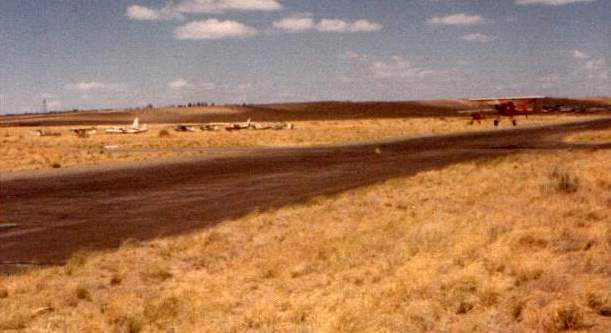
A 1974 photo of Doug Rhinehart touching down at Alameda Airport in his 1936 Rose Parrakeet (ourtesy of Dan Rhinehart).

A 1974 picture by Dan Rhinehart of a lineup of Beech Staggerwings at an airshow at Alameda Airport.
The main hangar of Seven Bar Flying Service is visible on the left.

A mid 1970s portrait by Dan Rhinehart of his father's Bonanza (on the left) at Alameda Airport.
Mark McManaman recalled, “My father, Bill McManaman, was a co-owner a 1960 Piper Comanche (N6781P) that was based at Alameda for a long time.
I soloed a PA-28-140 (Seven Bar flight school) on my 16th birthday in May of 1976.
Richard Massagee was my instructor, then I obtained my instrument ticket by working with Don Holt.
I ended up working for Seven Bar Flying service between 1979-82 (field maintenance, lineman, etc.).”
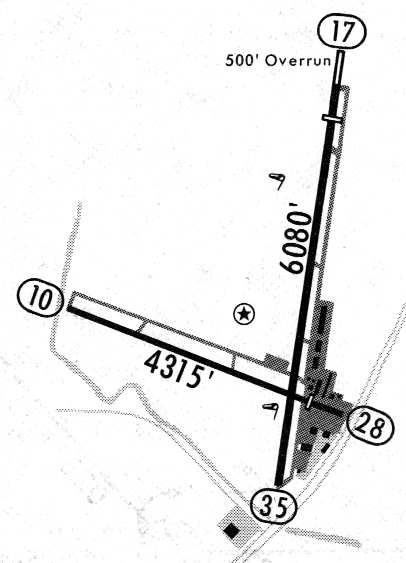
By 1978, an airfield diagram (courtesy of Steve Cruse)
indicated that Runway 17/35 had reached what would be its ultimate length of 6,080' (with a 500' overrun).
Both runways had parallel taxiways,
and a large paved ramp along the eastern side of the field had a large number of hangars & buildings.
Dan Rhinehart recalled, "The last time I was at Alameda airport was in 1978,
and it was in open land on the outskirts of the city."
The last of several airshows / fly-ins at Alameda Airport was the Walt Hall / Doug Rhinehart Memorial Fly-In,
held in 1979 by the New Mexico Antique Airplane Association.
It was marred by the death of Paul Muench,
a local airshow pilot who flew a gorgeous green, white & yellow Steen Skybolt.

An April 1981 aerial view looking north at Alameda Airport by Robert Morris, taken while on approach to Runway 35.
By 1982, the AOPA Airport Directory (courtesy of Ed Drury) listed Alameda's 2 runways
as asphalt 6,080' Runway 17/35 & asphalt 4,315' Runway 10/28,
and listed the operator as Seven Bar Flying Service.
According to Dan Rhinehart, Seven Bar Aviation later moved its operation to Albuquerque International Airport,
where they continue to operate an FBO.
Dan McGrew recalled, “7-Bar was closed down in the 1980s.
The last time I flew out of there was in a hot air balloon in 1989.”
According to Dan Rhinehart, "Alameda airport closed in the early 1980s
and the property was leased not sold (according to Seven Bar employees)
for the development of the Cottonwood Mall.
This explains why the perimeter road around the mall is named 'Seven Bar Loop'
and the entrance to the mall (the original airport entrance) is called Old Airport Road."

Curiously, the 1996 USGS topo map still depicted the entire airport,
even though the 1996 USGS aerial photo below clearly showed that the majority of the airport
had already been covered by new construction.
As depicted on the map, in addition to the 2 runways, the airfield had taxiways, a ramp, and several hangars.

In the 1996 USGS aerial photo,
a 2,400' portion of Runway 18/36 & its parallel taxiway are still perceptible, just north of the mall,
as well as a shorter section of the crosswind runway, just west of the mall.
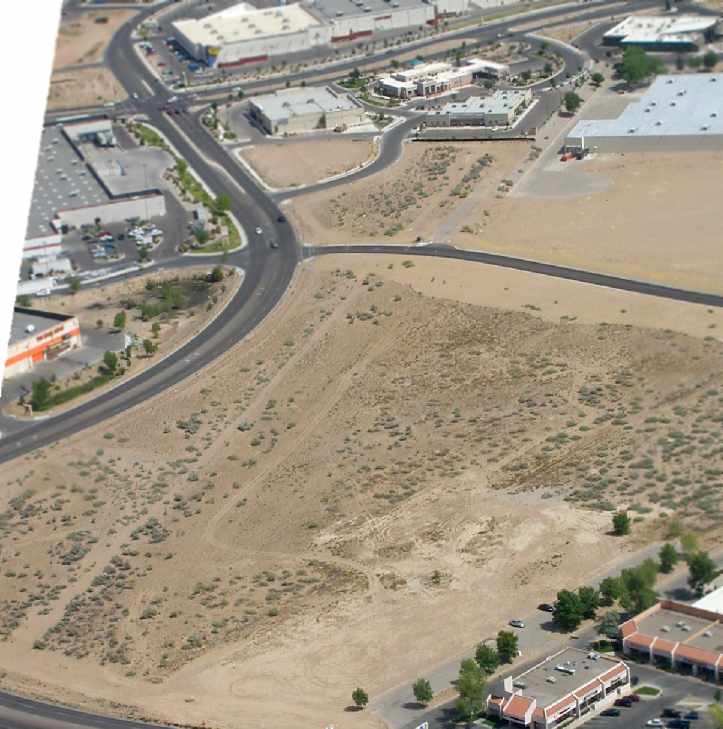
A 2003 aerial view by Dan Rhinehart of the traces of the former runway of Alameda Airport.
Dan Rhinehart reported in 2003, "I took some aerial photographs of the Cottonwood Mall / Alameda Airport
and I really couldn't tell you for sure but if you compare the [overhead] photograph to my pictures
you can see a couple of lines that seem to indicate where part of the runway was
and a small piece of faded asphalt that appears not to match the rest of the pavement
in the area that might be part of the taxiway?
But that's about it: a big mall & a couple street names that remind those of us that remember
that under all of this urban sprawl lies the ghost of Alameda airport."
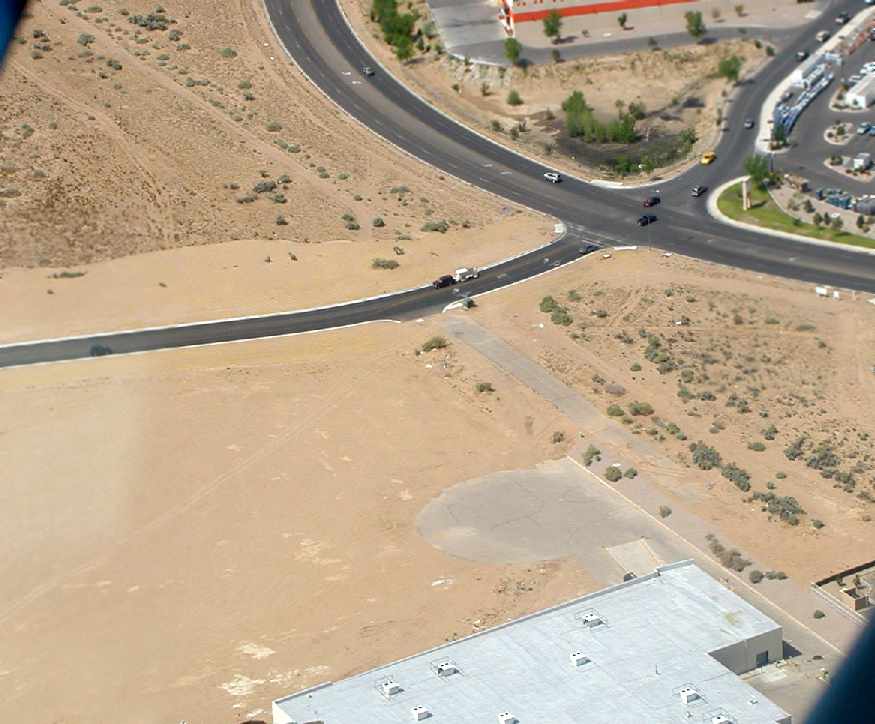
A 2003 aerial closeup of the remaining piece of runway pavement from Alameda Airport, by Dan Rhinehart.
"If you look closely you can see a small piece of taxiway in this picture.
This is the north end of the runway.
You will notice a warehouse in the picture that has a road running east/west just south of the warehouse.
Running parallel to the west side of the building you will see a piece of very faded blacktop
that doesn't seem to match anything around it.
There is what looks like a turn in area in the new blacktop onto this piece of old blacktop,
but if you look closely you will notice that this turn in area doesn't line up
with the last remaining piece of taxiway that went to Runway 17."
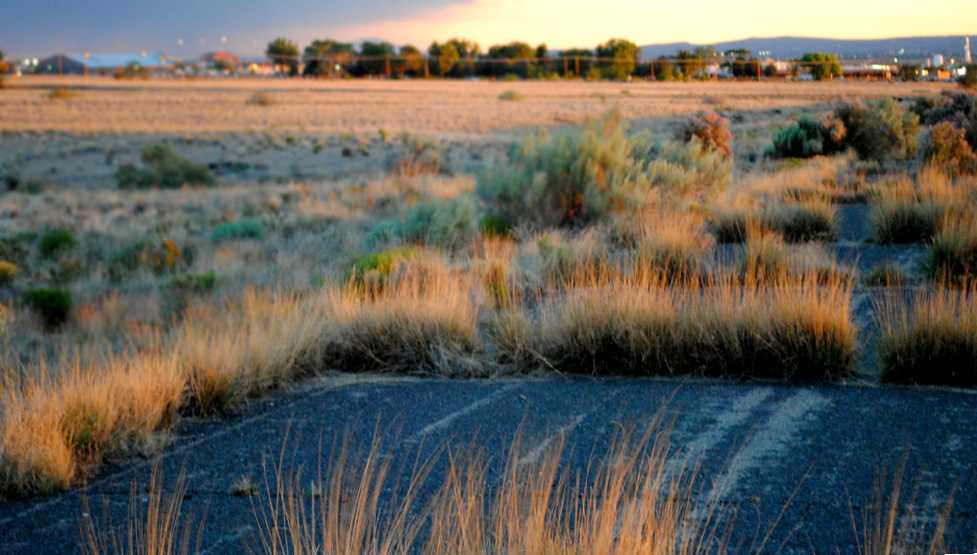
A 5/27/10 photo of the last remnant of this once-vibrant airport: a small section of Alameda Airport runway pavement.
Amazingly, as of 2014 a former Alameda hangar still marked “Seven Bar Aviation”
was photographed at the former Valencia Community Air Ranch where it had been relocated.
____________________________________________________
Since this site was first put on the web in 1999, its popularity has grown tremendously.
That has caused it to often exceed bandwidth limitations
set by the company which I pay to host it on the web.
If the total quantity of material on this site is to continue to grow,
it will require ever-increasing funding to pay its expenses.
Therefore, I request financial contributions from site visitors,
to help defray the increasing costs of the site
and ensure that it continues to be available & to grow.
What would you pay for a good aviation magazine, or a good aviation book?
Please consider a donation of an equivalent amount, at the least.
This site is not supported by commercial advertising –
it is purely supported by donations.
If you enjoy the site, and would like to make a financial contribution,
you
may use a credit card via
![]() ,
using one of 2 methods:
,
using one of 2 methods:
To make a one-time donation of an amount of your choice:
Or you can sign up for a $10 monthly subscription to help support the site on an ongoing basis:
Or if you prefer to contact me directly concerning a contribution (for a mailing address to send a check),
please contact me at: paulandterryfreeman@gmail.com
If you enjoy this web site, please support it with a financial contribution.
please contact me at: paulandterryfreeman@gmail.com
If you enjoy this web site, please support it with a financial contribution.
____________________________________________________
This site covers airfields in all 50 states.